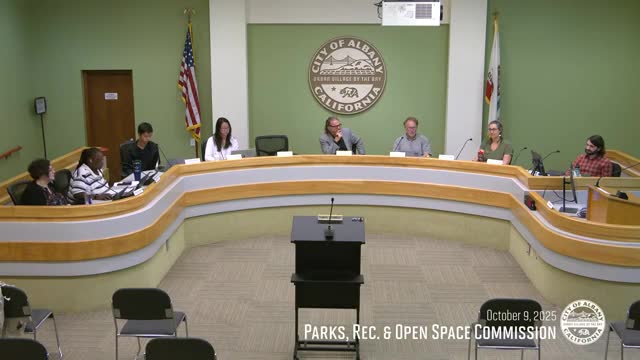Albany interns report on bat houses, creek surveys and fire-safety outreach on Albany Hill
October 10, 2025 | Albany City, Alameda County, California
This article was created by AI summarizing key points discussed. AI makes mistakes, so for full details and context, please refer to the video of the full meeting. Please report any errors so we can fix them. Report an error »

Margo Cunningham, Albany’s Natural Areas Manager, and habitat restoration intern Nina told the commission about summer and fall projects on Albany Hill, including two bat houses built from salvaged redwood, a creek biosurvey that found nutrient levels above ideal for aquatic life, and a planned November workshop linking native plants to fire resilience.
The interns’ work “helps people connect to the ecology of the hill,” Cunningham said at the commission meeting. Nina described three specific projects: bat-house construction, a benthic macroinvertebrate survey of the creek and public education on native plants and fire safety.
Nina said the bat boxes were built from salvaged redwood and will be mounted on eucalyptus trees that are not slated for removal, “about 15 or 20 feet up off the ground,” in the Monarch-protection zone on the hilltop. “Each of the bat houses, I believe, is either 14 or 16 inches wide and then 24 inches tall,” she said, and that each house can “hold up to 300 bats.” The bat boxes are intended to provide roosting habitat ahead of planned eucalyptus removals.
The interns and staff also carried out a creek biosurvey with Urban Tilth that sampled benthic macroinvertebrates and ran water-quality tests for dissolved oxygen, nitrates, phosphates and pH. Nina said the macroinvertebrate results were “only in the tolerant and mid range category,” and the chemical tests identified elevated nutrient levels, which she described as “not an ideal environment for the aquatic organisms.” She and Cunningham said planting and riparian-buffer work remain the primary local tools to improve conditions in the larger watershed.
Nina previewed a November native-plant and fire-safety workshop to be held on Albany Hilltop. The event will include plant giveaways, tabling by the fire department to address home hardening and a short tour of fuels-management techniques used on the hill. The intern said the training will aim to show residents how “native plants in their own landscape” support both biodiversity and fire resilience.
Cunningham noted the intern program began in May and continues through December, and that presentations are posted to the city’s YouTube channel. Commissioners and members of the public asked technical questions about bats, predator risk, counts and monarch interactions; Nina answered that bats are crepuscular hunters and that she would double-check any species-level interactions. Cunningham said pre-removal surveys for birds and bats would be done before any tree removal occurs.
The commission applauded the interns’ work and encouraged continued public outreach linking pollinators, native plants and fire-hardened landscaping.
The interns’ work “helps people connect to the ecology of the hill,” Cunningham said at the commission meeting. Nina described three specific projects: bat-house construction, a benthic macroinvertebrate survey of the creek and public education on native plants and fire safety.
Nina said the bat boxes were built from salvaged redwood and will be mounted on eucalyptus trees that are not slated for removal, “about 15 or 20 feet up off the ground,” in the Monarch-protection zone on the hilltop. “Each of the bat houses, I believe, is either 14 or 16 inches wide and then 24 inches tall,” she said, and that each house can “hold up to 300 bats.” The bat boxes are intended to provide roosting habitat ahead of planned eucalyptus removals.
The interns and staff also carried out a creek biosurvey with Urban Tilth that sampled benthic macroinvertebrates and ran water-quality tests for dissolved oxygen, nitrates, phosphates and pH. Nina said the macroinvertebrate results were “only in the tolerant and mid range category,” and the chemical tests identified elevated nutrient levels, which she described as “not an ideal environment for the aquatic organisms.” She and Cunningham said planting and riparian-buffer work remain the primary local tools to improve conditions in the larger watershed.
Nina previewed a November native-plant and fire-safety workshop to be held on Albany Hilltop. The event will include plant giveaways, tabling by the fire department to address home hardening and a short tour of fuels-management techniques used on the hill. The intern said the training will aim to show residents how “native plants in their own landscape” support both biodiversity and fire resilience.
Cunningham noted the intern program began in May and continues through December, and that presentations are posted to the city’s YouTube channel. Commissioners and members of the public asked technical questions about bats, predator risk, counts and monarch interactions; Nina answered that bats are crepuscular hunters and that she would double-check any species-level interactions. Cunningham said pre-removal surveys for birds and bats would be done before any tree removal occurs.
The commission applauded the interns’ work and encouraged continued public outreach linking pollinators, native plants and fire-hardened landscaping.
View full meeting
This article is based on a recent meeting—watch the full video and explore the complete transcript for deeper insights into the discussion.
View full meeting
